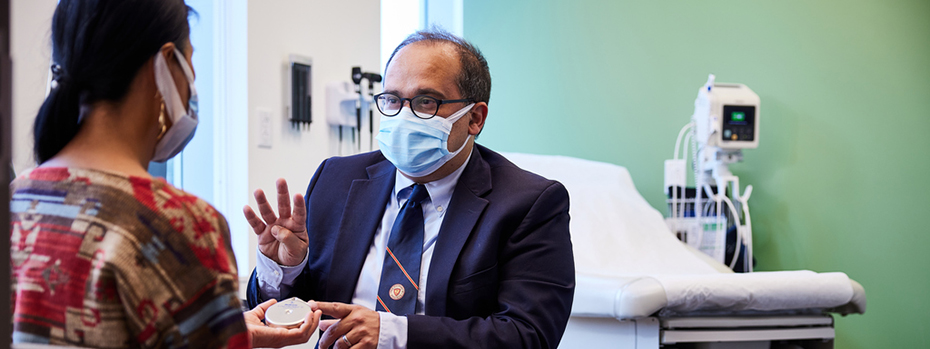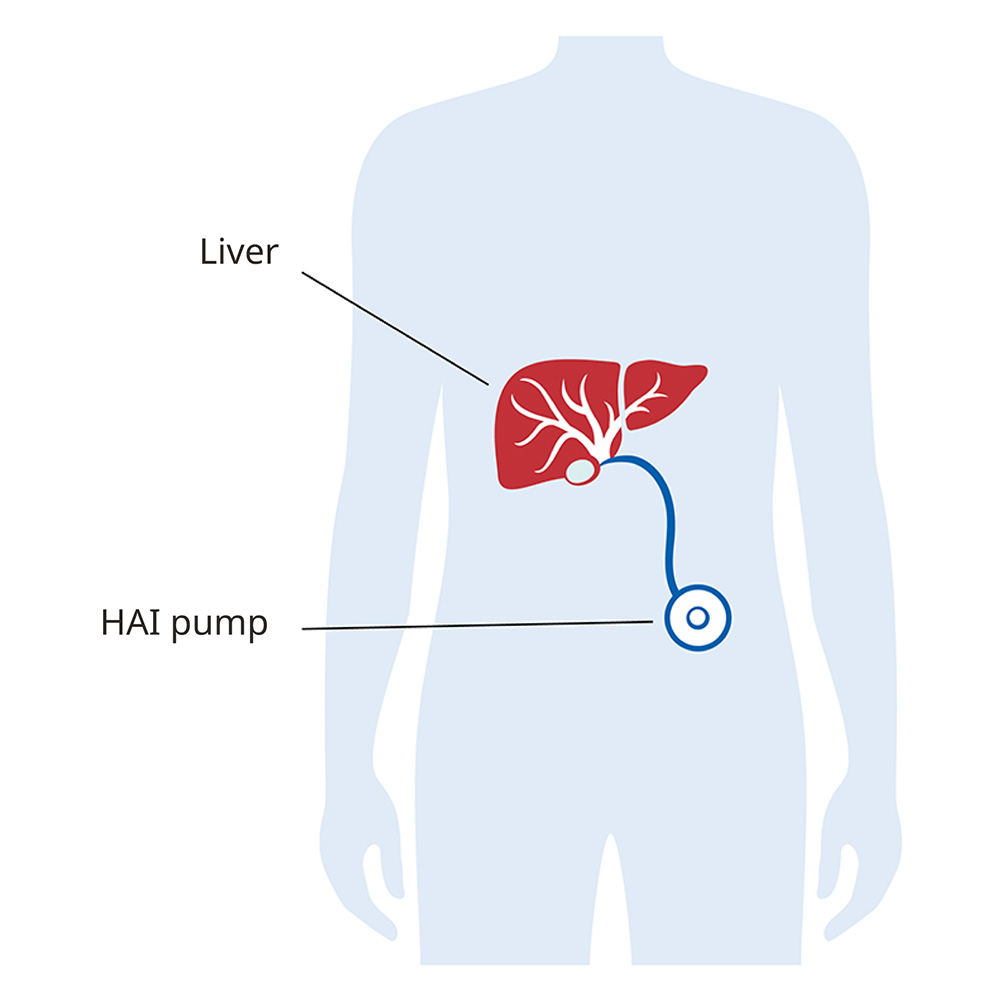Hepatic Arterial Infusion (HAI)

Hepatic arterial infusion is an important option for treating cancer in the liver.
HAI can help patients with cancer that:
- Started in the liver (primary liver cancer)
- Started in another part of the body and spread to the liver (metastatic liver cancer)
HAI is usually combined with other treatments such as chemotherapy. Studies show that patients who get HAI and chemotherapy live longer — and have a better quality of life — than patients who get chemotherapy alone.
Placing an HAI pump is a complex operation that requires a team of experts backed by the resources of a major medical center. The OHSU Knight Cancer Institute is a leader in this therapy.
What is hepatic arterial infusion?
HAI is a type of chemotherapy delivered by a pump connected to the liver. This lets doctors take advantage of the liver’s unique anatomy.
The liver gets most of its blood from the portal vein. But tumors in the liver often get blood from a different source — the hepatic artery. By using the hepatic artery, doctors can attack liver tumors from the inside with fewer side effects than traditional chemotherapy.
In HAI, doctors place a pump in the abdomen and connect it to the hepatic artery. The pump allows them to deliver a powerful dose of chemotherapy straight into the liver 24/7. The medication circulates inside the liver, killing cancer cells. The liver breaks down 95% of the medication, which means fewer side effects. Once the pump has been placed, most patients aren't aware of it.
The Knight Cancer Institute is a leader in HAI therapy. Our team of specialists has been performing this complex operation since 2016. We are the only hospital in the Pacific Northwest and among the few in the western U.S. to offer this therapy. We also have a program to support HAI patients after their procedure.
How does hepatic arterial infusion work?
The surgical team places a wireless pump about the size of a hockey puck under the skin of your abdomen. They connect the pump to a tube that feeds into the hepatic artery. The pump delivers chemotherapy to the liver for two weeks. Then the pump is recharged and the cycle repeats.
Hepatic Arterial Infusion Pump Placement

After surgery, patients usually stay in the hospital for four to six days to recover. Patients return for office visits every two weeks so the team can check progress and refill the pump.
The pump stays in place as long as needed to kill the cancer cells and to help keep cancer from coming back. Patients may have it anywhere from six months to six years.
Who gets hepatic arterial infusion?
HAI can help patients with:
- Colorectal cancer that has spread to the liver (also known as colorectal liver metastasis, or CRLM). About half of patients with colorectal cancer eventually develop CRLM. This is the most common reason to get an HAI pump.
- Primary liver cancer.
- Hepatocellular carcinoma.
- Bile duct cancer that starts in the liver (also known as intrahepatic cholangiocarcinoma). The Knight Cancer Institute is a national leader in using HAI for these patients.
- Other types of cancer that have spread to the liver.
Doctors may use HAI:
- After surgery to kill any cancer cells that might be in the liver.
- Before surgery to shrink tumors so they can be removed more easily.
- Instead of surgery, usually because the tumors lie too deep in the liver to be removed. Sometimes HAI shrinks the tumors enough to make them removable. When that is not possible, HAI can shrink the tumors enough to ease the burden of cancer.
Benefits of hepatic arterial infusion
HAI can help patients live longer and enjoy a better quality of life. For example, some patients have tumors that cannot be surgically removed. HAI extends the expected life span of these patients by about two years, according to a major study in the Journal of Clinical Oncology.
HAI has other benefits:
- HAI allows doctors to flood the liver with a powerful dose of medication, as much as 400 times higher than standard chemotherapy.
- The liver breaks down 95% of the medication, greatly reducing side effects.
- The medication is delivered 24/7 for two weeks at a time.
Limits of hepatic arterial infusion
Like any surgery, HAI therapy has some limitations and risks:
- Some patients may not be well enough for surgery to place the pump.
- Some patients have cancer that has spread beyond the liver.
- Any surgery carries a risk of complications. The risk is lower at hospitals where the procedure is done more often.
- HAI patients benefit from ongoing medical support after the procedure.
Learn more
- Chemotherapy for Liver Cancer, American Cancer Society
- Liver Cancer Diagnosis and Treatment, Knight Cancer Institute
- Cholangiocarcinoma Foundation
Location
OHSU Knight Cancer Institute Surgical Oncology Clinic, South Waterfront
3485 S. Bond Ave.
Portland, OR 97239
Free parking for patients and visitors
Refer a patient
- Refer your patient to OHSU.
- Call 503-494-4567 to seek provider-to-provider advice.
Pump it up
Doctors gave Jerry Widawski less than a year to live. But he didn't give up. Perseverance and an HAI pump helped him bounce back.